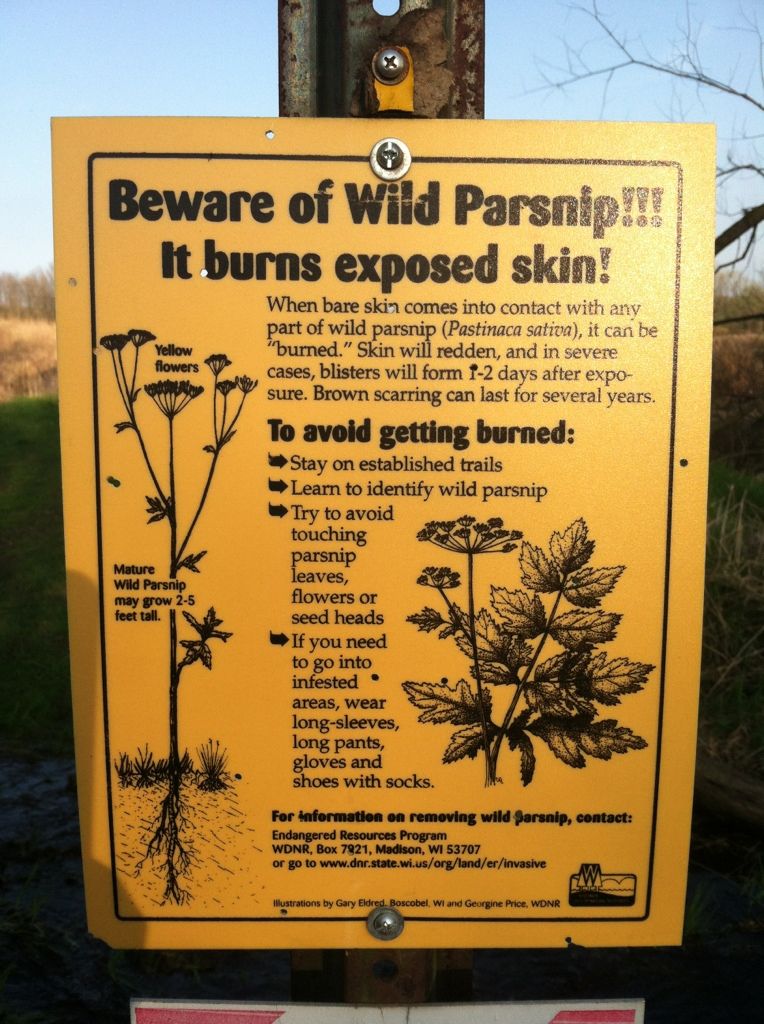Did some research and found this.............
DESCRIPTION: Wild parsnip is a member of the Umbelliferae (parsnip) family. Rosettes grow close to the ground and bear leaves averaging six inches in height. The plant has a long, thick taproot, which is edible. Flowering plants produce a single, thick stem that contains hundreds of yellow umbellate flowers. The lateral flowers often overtop the terminal flowers. Depending on the habitat and growing conditions, individual flowering plants range to over four feet in height. Leaves are alternate, pinnately compound, branched, and have saw-toothed edges. Each leaf has 5-15 ovate to oblong leaflets with variable toothed edges and deep lobes.
Wild parsnip can be confused with prairie parsley (Polytaenia nuttallii), a native prairie species listed as threatened in Wisconsin. Its flowers and leaves resemble those of wild parsnip. Comparatively, flowers of the prairie parsley plant are light-yellow, sparse, and typically found at the end of the stem. The leaves are pinnately compound like those of the wild parsnip, but are oblong with few teeth.
DISTRIBUTION AND HABITAT: Wild parsnip is tolerant of a wide range of conditions, including dry, mesic, and wet-mesic prairies; oak openings; and calcareous fens. It is shade-intolerant and prefers sunny conditions.
LIFE HISTORY AND EFFECTS OF INVASION: Wild parsnip can cause phytophotodermatitis to the skin. If the plant juices come in contact with skin in the presence of sunlight, a rash and/or blistering can occur, as well as skin discoloration that may last several months.
This species reproduces readily from seed. Seeds are fairly large and many are produced on one plant. As a monocarpic perennial, wild parsnip spends one or more years as a basal rosette. When conditions are favorable, it flowers, produces seed, and dies. Look for the large, coarse, flower spikes and yellow flowers from the first of June to the middle of July (although some plants may continue flowering through late summer). Optimal growing conditions apparently stimulate an increase in flowering. Apparently seeds take at least three weeks from flowering to become viable.
Wild parsnip slowly invades an area in waves following initial infestation. Once the population builds, it spreads rapidly. This species is an aggressive, Eurasian weed that frequently invades and modifies a variety of open habitats.
CONTROLLING WILD PARSNIP
CAUTION: Care should be taken to avoid skin contact with the juices of this plant. Proper clothing (gloves and a long-sleeved shirt) must be worn to prevent the phytophotodermatitic effects.
Mechanical Control: The best way to control wild parsnip is early detection and eradication. A very effective control method is to cut the entire root just below ground level with a sharp shovel or spade. Cutting below ground level prevents resprouting. In some soil types in wet
conditions, the plants can be pulled out of the ground by hand. All seeds must be removed from the site and disposed of in a landfill or by burning.
If the population is too large to hand-cut or pull, a power brush-cutter can be used just after peak flowering and before the seeds set. Plants may resprout when cut above the ground, and should be cut again a few weeks later to prevent flowering. Cutting done after seed set will greatly reduce the likelihood that the plants will be able to resprout and flower. Plants cut at this time must all be gathered and removed from the site to prevent mature seed from developing and falling to the ground. Another effective way to eliminate reseeding is to hand-collect all seeds after they have set. If control of flowering or seeding plants is carried out over several years, the population will decrease as the seed bank is depleted.
Burning does not seem to impact the plants themselves -- they quickly resprout. However, in the darkened soil following a burn, these rosettes are easy to recognize and can be controlled by hand-digging. Prescribed burning stimulates increased growth in prairie species that may potentially decrease parsnip populations through competition.
Chemical Control: Chemical controls are effective, but should be used sparingly on quality habitats. The best method is to burn the site, then follow with spot applications of herbicide. Immediately after a burn, wild parsnip is one of the first plants to green. Herbicides such as 2,4-D, Escort® or glyphosate can be spot applied to the basal rosette of the parsnip. Adult plants should be spot treated during the time of plant bolting until flowering (mid-May to mid-June) or in the fall targeting plants in the rosette stage. Effective spot treatment mixtures are 1-3% active ingredient glyphosate mix or a 1 ounce Escort® plus surfactant mix.
[ Post made via iPhone ] 





